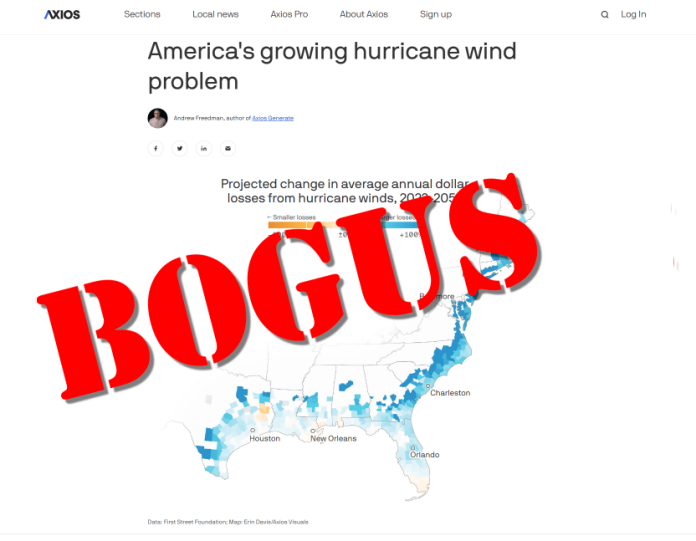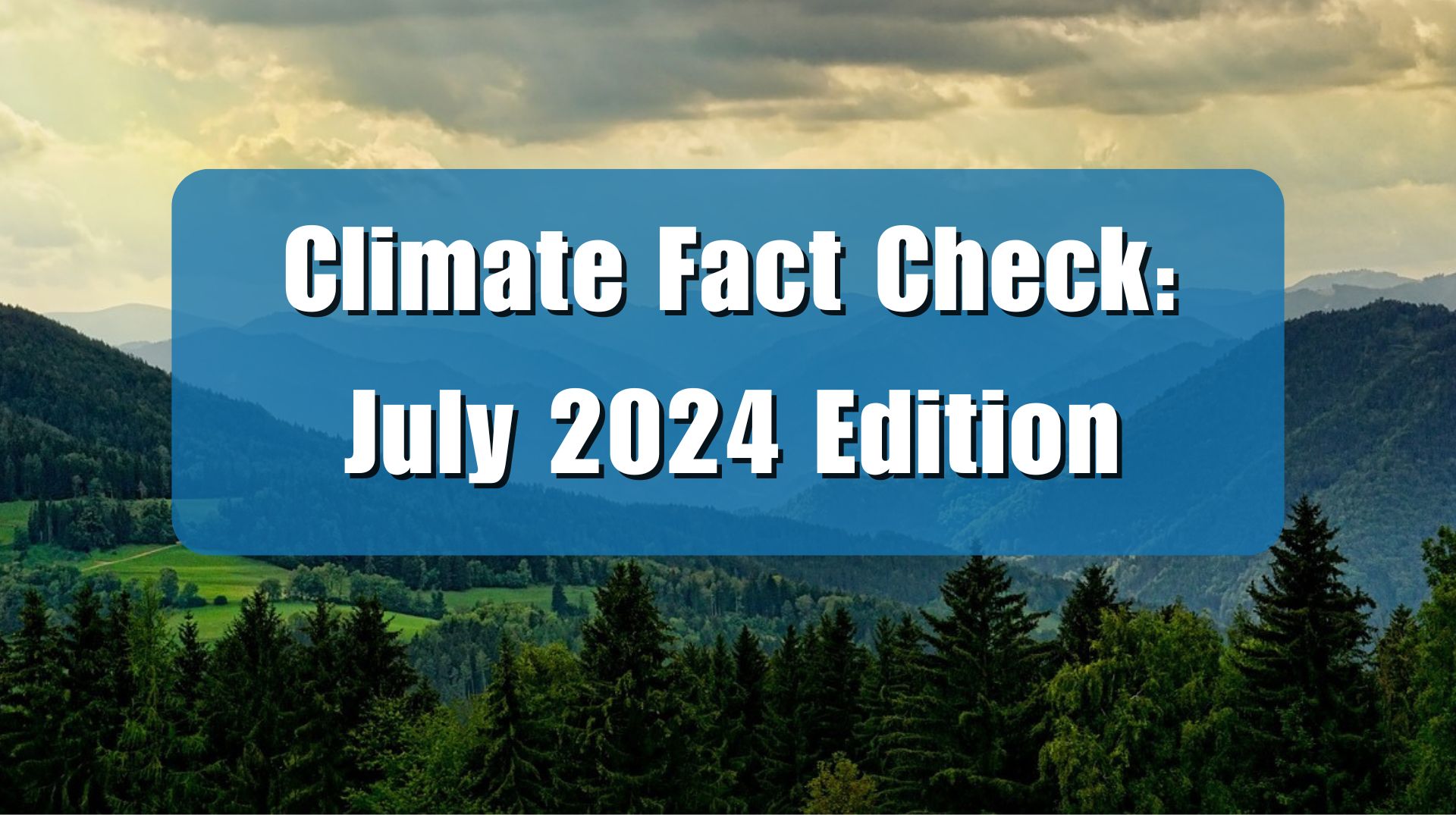An article in Axios, written by Andrew Freedman, claims increased hurricane winds due to rising temperatures driven by increasing carbon dioxide concentrations may result in more hurricane damage losses along the US East Coast, Florida Coasts, and the Gulf Coast. The article is misleading. The article cites climate model projections to support its claims, rather than data, because data does not show that the number or intensity of hurricanes have increased during the recent period of modest global warming. The study is also misleading because it fails to consider more germane factors responsible for rising hurricane costs.
The Axios article, titled “More than 13 million people to see new hurricane wind risks,” is based on a research from the First Street Foundation, a group formed to define the risk to people and property from climate change in the United States. The study, uses a “… property-specific and climate-adjusted hurricane wind model that calculates the likelihood of a property being exposed to and damaged from a hurricane’s winds.”
The study, by retired MIT meteorology professor Kerry Emanuel, neither provides nor creates new findings, but rather uses historical data combined with computer models to make guesses on how coastal and other properties would be more “at risk” in the future. The non-profit group even created a slick interactive website to hawk the model results as if they were evidence based to an unsuspecting public, seen in the screen capture below from riskfactor.com:
As explored in Climate Realism, here and here, for example, climate models are seriously flawed. The basic projection they make is the global average temperature in response to additional carbon dioxide concentrations, and after more than thirty years and 6 generations of models, the model projections still run too hot. On top of basic physics, models also incorporate different modelers’ assumptions about how various features of the earth will respond to rising temperatures and CO2, referred to as “feedback mechanisms” or “feedback loops,” tending to enhance or diminish temperature increases. Model simulations are tested for accuracy against simulations from other models, rather than available data, in the Coupled Model Intercomparison Project. It amounts to 30 years of Garbage In-Garbage Out or GIGO. Nowhere is this clearer than in climate projections of hurricanes.
For example, after Category 5 Hurricane Katrina hit New Orleans in late August 2005, scientists and pundits alike began claiming that sort of devastation was the “new normal” and that hurricane frequency and intensities were only going to get worse. Climate model projections were cited as “proof” for such claims. Former Vice-President Al Gore exploited the Katrina disaster in a call for climate action.
In a speech at Sierra Club’s National Environmental Convention and Expo in San Francisco on 9 September 2005, Gore said, “The era of procrastination, of half measures, of soothing and baffling expedience of delays, is coming to a close. In its place we are entering a period of consequences.”
In Katrina’s aftermath, climate activists beat a steady drumbeat warning of hurricane doom. Here are a just a few examples: “Warming seas cause stronger hurricanes“, Nature, 2006 “Are Category 6 Hurricanes Coming Soon?“, Scientific American, 2011, “Global warming is ‘causing more hurricanes’“, The Independent, 2012, “A Katrina hurricane will strike every two years“, Science Nordic, “‘Katrina-Like’ Hurricanes to Occur More Frequently Due to Warming” in US News & World Reports, “Hurricanes Likely to Get Stronger & More Frequent“, Climate Central, 2013 – About a study in PNAS by Kerry Emanuel et al.
Note the last one is from the same author, Kerry Emanuel, as the current study being touted by Axios.
Yet, after Katrina, the United States entered a hurricane drought. Between October 24, 2005 and August 17, 2017, a 4,323-day (142-month, 12-year) period, the United States entered its longest recorded period of no major hurricane of category three or higher making landfall within the country. Climate models failed to simulate the hurricane drought. Indeed, in direct contrast to the evidence, throughout the drought, as seen above, climate alarmists continued to cite climate model projections to claim climate change was making hurricanes either more frequent, more powerful, or both.
Real-world data refutes the claims of worsening hurricanes in the United States. Below, in Figure 1A/1B, two graphs of data from Dr. Roger Pielke Jr. show that both major hurricanes and hurricanes per se have experienced a declining trend for more than a century during the period of modest warming:
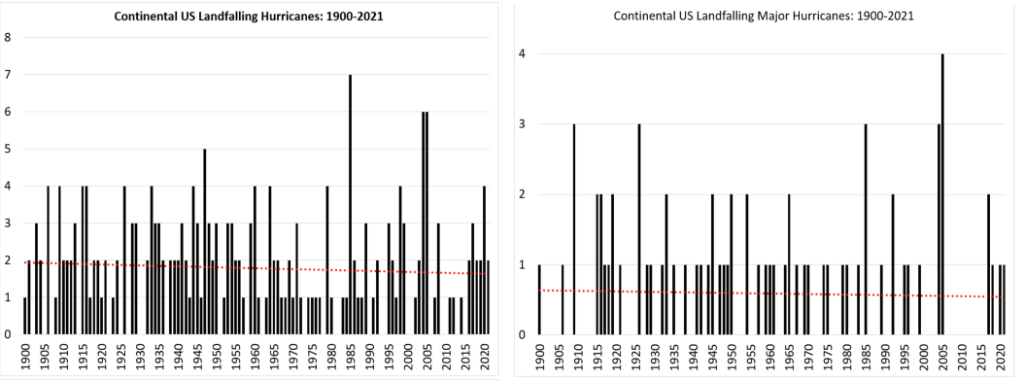
Pielke points out that the International Panel on Climate Change (IPCC) confirms his findings, writing, “[t]he IPCC has concluded that since 1900 there is ‘no trend in the frequency of USA landfall events.’ This goes for all hurricanes and also for the strongest hurricanes, called major hurricanes.”
Also, it is not just the United States that has experienced a declining hurricane trend, there has been a downtrend globally:
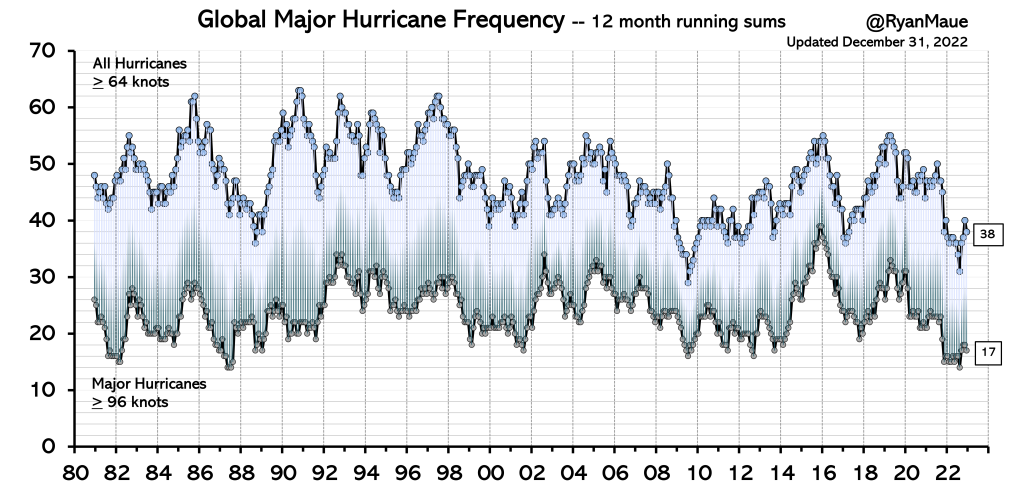
The data and the position of the IPCC flies in the face of the claims made in the Axios article, and the computer climate model projections behind it, predicting a dire future for U.S. coastal residents, seen in Figure 3 below.
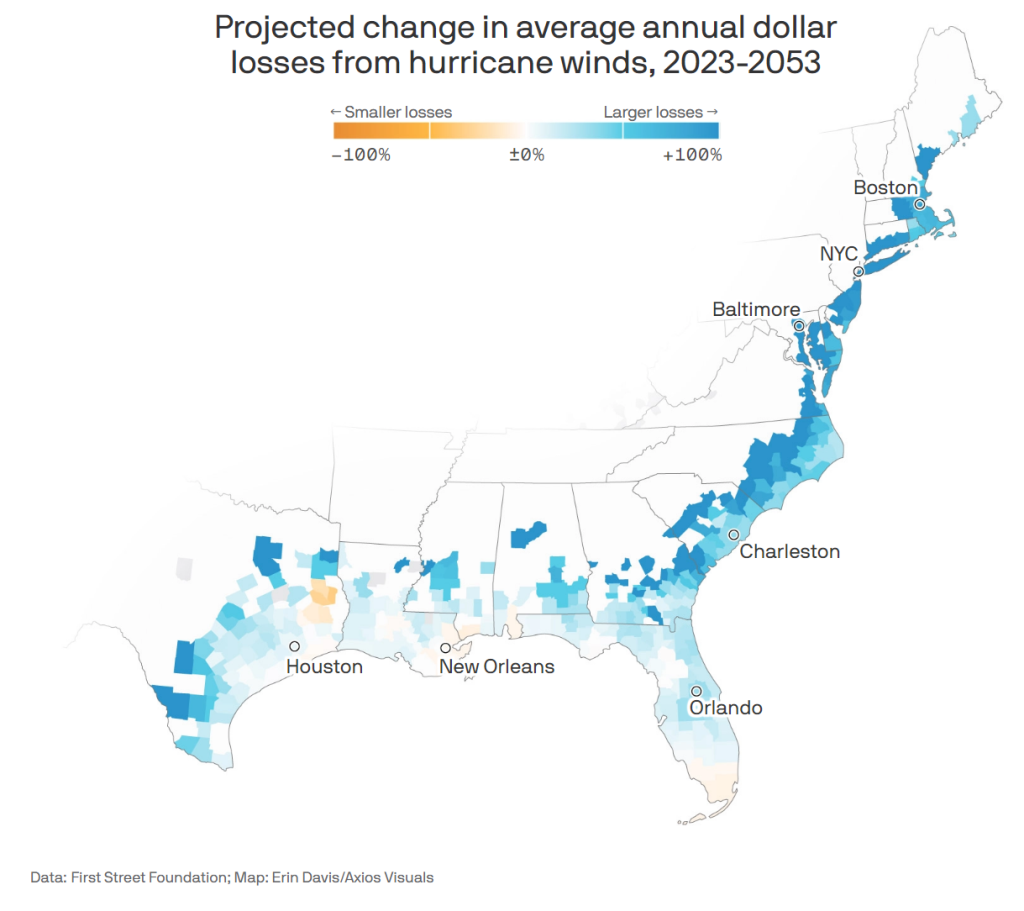
With hurricanes and major hurricanes either trending slightly downward over the past century of modest warming, or exhibiting “no trend,” per the IPCC, any increase in hurricane losses must be due to factors other than climate change—yet Axios’ article, and the study it references, downplay or ignore entirely other likely factors. Indeed, Axios writer, Freedman, and the study’s author, Emanuel, miss the real driving force behind disaster losses on U.S. coasts: basic economics.
Fact: many people like living on coastlines, evidently considering the threat of hurricanes worth the risk to get the benefits of a view and pleasant lifestyle provided by the ocean. According to a U.S. Census Bureau report from 1960 to 2008, coastal U.S. population more than doubled with a measured increase of 124.7 percent.
Along with more people living on the coasts, comes more development of property, and with more development and people, come higher property prices. Any realtor can tell you this.
Yet, both Freedman and Emanuel ignored the fact that regardless of hurricanes’ responses to climate change, because more people and more, more expensive, properties are located in areas historically prone to hurricane impacts, when hurricanes strike, the damage costs will be significantly higher now than in the past. This is an effect of demographic and economic trends, not changes in hurricane behavior.
Once again, rather than exercising a little journalistic fact checking of the available data, Axios, CNN, USA Today, and other mainstream media outlets prone to hyping the climate crisis narrative, put alarming headlines above the truth. Data on hurricane trends and widely recognized, though not as widely publicized, weaknesses in the climate models undermine any attempts to link higher damage costs from hurricanes to climate change. Demographics and economics explain the increase in hurricane related costs, not climate change. This bogus combination of shoddy science and even shoddier journalism has done a disservice to their readers.












